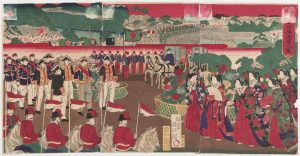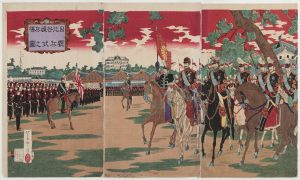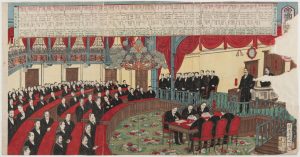Reformed Government and Military Prints
When Matthew C. Perry and his “Black Ships” arrived on the shores of Japan, Japanese military and political leaders faced a sobering wakeup call that Japan was not prepared to defend against Western powers. The following three prints depict the variety of ways that Japan had Westernized in order to meet the competition of Western nations. The common theme of the marriage between Western, modern technology and traditional Japanese values– combining a new Western government with a traditional Japanese identity– draws these prints together in their significance.
“Famous Views of Tokyo”, 1878:

The print depicts a large gathering of Tokyo locals at, what seems to be, the East Imperial Gardens (evidenced by the well-groomed chrysanthemums and Manseibashi Bridge in the background). Throughout the print, you can find not only the Japanese national flag but the Military flag and the Emperor’s flag. The presence of so many national and cultural symbols suggests the event occurring in this garden is of great national and societal importance. The man in the middle, more decorated than the rest, would likely be the Emperor. In the crowd of women, the Empress stands out because of her jūnihitoe (multi-layered kimono) and golden hairpiece. Though it is not explicitly stated anywhere in the print or by the artist, this could be a depiction of the first chrysanthemum-viewing party sponsored by the Emperor in his gardens in 1878. The women are wearing elegant kimonos, while the men are taking cues from American-military formal events, and wearing their uniforms. The print cuts distance with red fog to feature the Manseibashi Bridge, the first Western-style bridge built in Japan, to highlight another Japanese variation of Western culture.
“Military Review at Hibiya Parade Ground”, 1889:
“Military Review at Hibiya Parade Ground” is a print created in 1889 that puts the modernized Japanese military on display. In the image, the audience is provided with a spectator seat to a formal military ceremony known as “pass-in-review,” where a military leader presides over his soldiers as they march past him.

This print places the Emperor on the right side of the image, nobly seated upon a white horse in elaborate Western military dress, and surrounding the Emperor are his high-ranking military officers mounted on their horses as well. To the left is the well-structured general body of the military organized in ranks similar to that of American and British armies, complete with their Western-style uniforms. This print serves as another example of the Japanese depicting the fusion of Western technology and Eastern ethics, a concept championed by Japanese leaders during the Meiji Restoration in order to draw Japan closer to acting as a world superpower while maintaining their national identity.
“First Meeting of the National Diet”, 1891:

This print by Yousai Nobukazu depicts the Western-style Japanese parliament in action. The National Diet, A bicameral legislature mimicking the United States Congress, featured elected representatives from each prefecture, whose names are listed at the top of the print, organized by principality. Structurally this image is nearly identical to that of a meeting of the United States Congress, yet it maintains its Japanese distinction through the usage of red coloring in the image, and by including some Japanese men still wearing their topknot. The print is a testament to the idea that the Meiji government wanted to project their competence and ability in executing a Western form of governing while continuing to maintain the Japanese culture.
These prints reveal the profound extent to which Japan adopted and normalized Western customs and systems, transforming them into a new, “modern” Japanese tradition. For many Japanese, one foot in the traditions of the past and one step to the Western future was the path to greatness. The artists who created these pieces wanted to showcase the Japanese narrative of modernization: a story of progress and growth to share with the world. To the modern observer, these prints present the glorious evolution of Japan’s politics and military viewed through the eyes of a proud citizen.
Stephen Hu (’23), Evan Feldman (’22), Lavanya Attavane (’22)